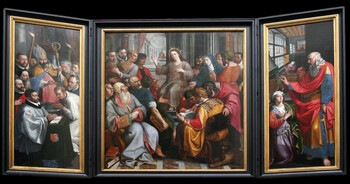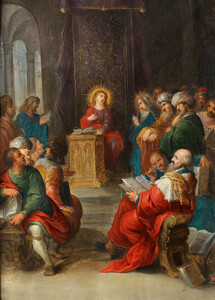13.000 €
Christ’s dispute with the doctors in the temple
Oil on panel : 69,4 X 55,0 cm
Signed (worn) bottom right “Do. ffra..k:”
Circa 1628/30 - 1642
Circa 1628/30 - 1642
Frame : 82,7 X 68,3 cm
In short
Frans Francken the Younger was an important, productive Antwerp painter of bliblical scenes.
This painting represents 12-years old Christ beating specialists at a discussion on religious matters in the Temple in Jerusalem.
About Frans Francken II
Flemish painter
Antwerp 1581 – 1642 Antwerp
Important history painter of biblical, mythological and allegorical subjects.
He also painted altar scenes and innovative subjects such as collector’s cabinet interiors or witches’ scenes.
Son and most likely pupil of Frans Francken I (1542 – 1616). He probably also studied under his uncle, Hieronymus Francken I (circa 1540 – 1610), in Paris.
Most important member of the Francken-family, which counted many painters over three generations.
In 1605 he became free master in the Antwerp Guild of Saint Luke. In 1615 he was elected its dean.
He was a very productive painter, who lead a large workshop, including his brothers and his sons. A lot of his workshop’s production (copies and routine replicas) was commissioned by dealers who exported them to Spain.
He often collaborated with other well-known painters, adding figures in their landscapes or interior scenes.
Frans II started painting in a typical, a bit old-fashioned Mannerist style, strongly influenced by his uncle Hieronymus I, and gradually evolved under the influence of Rubens.
About the subject of our painting
"Christ’s dispute with the Doctors" refers to an episode in the life of Jesus, specifically when he was 12 years old, described in the Gospel of Luke. It depicts Jesus in the Temple in Jerusalem, where he was found discussing religious teachings with the doctors (religious scholars), much to the astonishment of the elders.
The scene in Luke's Gospel is significant as it is the only event mentioned from Jesus's later childhood. It is also interpreted as foreshadowing Christ's later role as a teacher and his wisdom surpassing that of established religious leaders.
About our painting
This is a rare subject in Flemish painting of the first half of the 17th century.
Frans’ II father, Frans I, had painted this subject (with a completely different composition) at the centre of a large, important triptych for the altar of the Schoolmasters and the Soap-boilers in the Cathedral of Antwerp in 1587. It is still there.
A small, clumsy painting on copper, sold at Bonhams London, 30/10/13, as by Frans III (the son of our Frans II) for 2.500 £ = 2.920 €, copies our painting.
About our monogram
Frans Francken II used three types of signature:
- ‘D.J. f.franck’ (‘dj’ stands for ‘de jonge’, that is ‘the younger’).
Frans Francken II saw himself as the younger, while his father, Frans I (1542 – 1616) whom he then saw as the elder, was still alive and working; he used this signature until 1616.
- ‘f.francken’ after his father’s death in 1616.
- ‘D.O. f.franck’ (‘d.o.’ stands for ‘de oude’, that is ‘the elder’).
Frans II used this signature once his son, Frans III, started painting, circa 1628/1630, until his death in 1642. Our painting dates from this last period.
The same dates apply to his types of monogram:
- “DJFF”: until 1616.
- “FF”: 1616 – 1628/1630.
- DOFF”: 1628/1630 – 1642.
About eyeglasses
Right of the centre an old man is holding his eye glasses to have a good look at the book that his colleague is holding.
Eyeglasses (“discs for the eyes”) seem to have been invented in Italy, probably in Pisa, during the late 13th century. Florence, which already had a large glass industry, became an important production centre.
Following the invention by Guttenberg of the printing press during the middle 15th century and the availability of books, newspapers and engravings to the ‘common’ man, its use became widespread.
These early spectacles did not have sides yet; they were used as a pince-nez. Therefore they were not easy to keep in place. While reading one had to hold his head back or simply hold them in place with one hand. The best lenses were produced in Italy (Florence), the best frames in Germany, in Nuremberg and Regensburg.
Why should you buy this painting?
Because it is a nice and still affordable painting by Francken.
Comparative paintings
Click photos for more details


